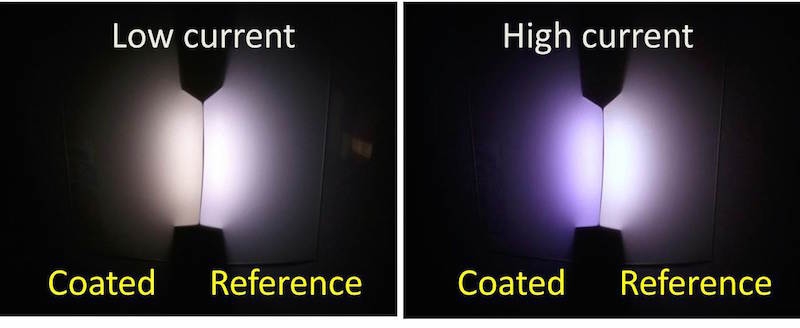
Products
Lighting & HVAC
Is “cozy” and warm LED lighting on the horizon?
November 20, 2014 | By Anthony Capkun

November 20, 2014 – Researchers from the Netherlands say they have found a “novel way” to ensure the LED lighting of the future is not only energy efficient but also emitting a “cozy warmth”.
“We demonstrated a seemingly simple—but, in fact, sophisticated—way to create LED lights that change in a natural way to a cozy, warm white colour when dimmed,” said Hugo Cornelissen, a principal scientist in the Optics Research Department at Philips Research Eindhoven (a corporate scientific research entity owned by the company Royal Philips in the Netherlands).
PHOTO: At low current, the coated LEDs emit a “cozy, warm glow” compared to uncoated reference LEDs. Photo © Hugo J. Cornelissen.
Incandescent lamps emit warmer colours when dimmed, and Cornelissen says our general preference for redder colours in low-light situations might even have developed far back in time, when humans “experienced the daily rhythm of sunrise, bright daylight at noon, and sunset, each with their corresponding colour temperatures”.
LEDs, on the other hand, don’t normally change colour at different light intensities, so the Dutch team tried what they call “an entirely different approach” to creating cozy LEDs. They had noticed that, when they embedded LEDs in coated textiles or transparent materials, the colour of the emitted light would sometimes change.
“After finding the root cause of these effects and quantitatively understanding the observed colour shift, we thought of a way to turn the undesired colour changes into a beneficial feature,” said Cornelissen.
They began with cold white LEDs, which can be made from blue LEDs surrounded by a material known as a phosphor. Part of the blue light is absorbed by the phosphor and re-emitted at a different colour. The multiple colours combine to form white light. Cornelissen and his colleagues knew the colour of the white light could be shifted toward the warmer end of the spectrum were more of the blue light to be absorbed and re-emitted by the phosphor. So they developed a temperature-dependent way to create this shift.
They made a coating from a composite of liquid crystal and polymeric material. The composite normally scatters light but, if heated above 48 C, the liquid crystal molecules rearrange and the composite becomes transparent.
When the team covered white LEDs with the coating and turned up the power, the temperature increased enough to make the coating transparent, and the LEDs emitted a cold white colour. When the power was turned down, the coating reorganized into a scattering material that bounced back more of the blue light into the phosphor, generating a warmer glow.
The scientists later fine-tuned the LED design and used multiple phosphors to create lights that comply with industry lighting standards across a range of currents and colours.
“We might see products on the market in two years, but first we’ll have to prove reliability over time,” noted Cornelissen. The team believes the new lights could help speed up acceptance of LED technology, especially in the residential and hospitality markets, “where there is a need to create a warm and cozy atmosphere”.
Print this page